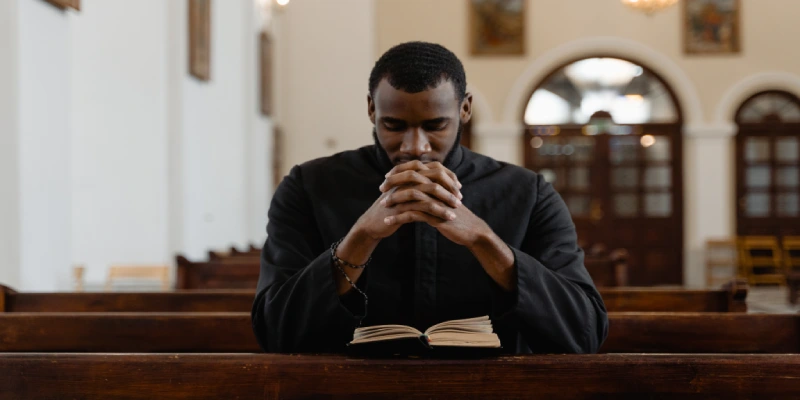Praying with Purpose: How to Make Your Prayers More Effective
Updated: July 30, 2024
38
Prayer is a fundamental practice found in nearly all cultures and religions, serving as a means of communication with a higher power, be it God, gods, spirits, or the universe. It is a way to express gratitude, seek guidance, request assistance, or simply connect with the divine. The act of praying can be deeply personal, communal, structured, or spontaneous, reflecting the diverse ways humans seek to engage with the sacred.
Why Do People Pray?
People pray for various reasons, including seeking comfort in times of distress, expressing gratitude for blessings, asking for help or guidance, and cultivating a sense of connection with something greater than themselves. Prayer can also be a way to reflect on one’s life and actions.

Benefits of Praying
Spiritual Benefits
Prayer strengthens spiritual beliefs and fosters a deeper connection with one’s faith. It provides a sense of purpose, hope, and meaning, helping individuals navigate life’s challenges with a stronger spiritual foundation.
Emotional Benefits
Engaging in prayer can lead to emotional healing and stability. It offers a safe space to express emotions, release stress, and find solace. Prayer can also promote feelings of peace, contentment, and emotional resilience.
Physical Benefits
Research has shown that prayer can have positive effects on physical health. It can reduce stress, lower blood pressure, and improve overall well-being. Regular prayer practices can also contribute to a healthier lifestyle by encouraging mindfulness and relaxation.
The Power of Prayer
Prayer has been shown to have numerous benefits for mental, emotional, and spiritual health. It can reduce stress, provide a sense of calm, and foster a positive outlook on life. Spiritually, prayer can strengthen one’s faith and provide a deeper sense of purpose and meaning. There are countless stories of prayers being answered in miraculous ways. Whether it’s a recovery from illness, finding lost items, or receiving guidance during difficult decisions, these stories highlight the power of prayer in everyday life.
Various Prayer Techniques
- Meditation: Sitting in silence and focusing on your breath or a mantra to quiet the mind and connect with the divine.
- Affirmative Prayers: Speaking positive affirmations to align yourself with your desired outcomes and higher truths.
- Gratitude Prayers: Expressing thanks for the blessings in your life fostering a sense of appreciation and positivity.
- Intercessory Prayers: Praying on behalf of others, asking for divine intervention or blessings for their well-being.
Common Prayer Practices in Different Religions
Christianity
In Christianity, prayer is a central practice. Christians pray individually and collectively, using structured prayers like the Lord’s Prayer, spontaneous personal prayers, and meditative practices such as contemplative prayer.
Islam
Muslims pray five times a day facing Mecca, performing a series of movements and recitations known as Salah. This disciplined practice helps maintain a constant connection with Allah.
Buddhism
Buddhist prayers often take the form of meditation and chanting. Practices like mindfulness meditation and loving-kindness meditation help cultivate awareness and compassion.
Hinduism
Hindu prayer practices include chanting mantras, performing rituals (puja), and meditating. These practices honor various deities and seek blessings, guidance, and spiritual growth.
Types of Prayers
Praying Without Ceasing
The concept of “praying without ceasing” comes from Christian teachings, specifically from the Apostle Paul in the New Testament. It emphasizes maintaining a constant state of prayerfulness and staying connected to God throughout the day in every activity and thought. This form of prayer encourages a continuous relationship with the divine, integrating spirituality into daily life.
Praying to God and the Power of Faith
Praying to God is a common practice in many religions. It involves seeking divine intervention, guidance, and blessings. The power of faith in prayer lies in the belief that God listens and responds to prayers, providing strength and hope. Faith enhances the effectiveness of prayer, fostering trust in a higher power and reinforcing spiritual resilience.
The Significance of the Lord’s Prayer
The Lord’s Prayer, also known as the “Our Father,” is central to Christianity. It is a model of prayer given by Jesus to his disciples. The prayer is significant for its comprehensive nature, covering praise, petition, and forgiveness. Different translations of the Lord’s Prayer reflect various theological and linguistic nuances, enriching its meaning for believers worldwide.
Islamic Prayer Times
In Islam, prayer (Salah) is performed five times a day at designated times. These prayers are Fajr (dawn), Dhuhr (midday), Asr (afternoon), Maghrib (sunset), and Isha (night). Praying at these times is obligatory for Muslims and signifies discipline, devotion, and submission to Allah. Each prayer time is a reminder of the presence of God in daily life.
Tools for Prayer
Praying Emoji and Its Use in Modern Communication
In the digital age, the praying emoji (🙏) has become a popular symbol in online communication. It is used to express gratitude, hope, and support, transcending language barriers and conveying a sense of solidarity and compassion in digital interactions.
How to Pray the Rosary and Its Significance in Catholicism
The rosary is a significant devotional tool in Catholicism, consisting of a series of prayers and meditations on the life of Jesus and the Virgin Mary. Each bead represents a specific prayer, guiding the devotee through a reflective and meditative practice that deepens faith and spiritual connection.
Serenity Prayer and Its Calming Effect on the Mind and Spirit
The Serenity Prayer, widely known in recovery communities, is a simple yet profound plea for peace and wisdom. It asks for serenity to accept things one cannot change, courage to change the things one can, and wisdom to know the difference. This prayer can have a calming effect, providing clarity and strength in challenging times.

Praying in Different Languages
Pray Meaning in Hindi, Bengali, Tamil, and Marathi
In Hindi, “प्रार्थना” (Prarthana); in Bengali, “প্রার্থনা” (Prarthona); in Tamil, “வேண்டுதல்” (Vēṇṭutal); and in Marathi, “प्रार्थना” (Prarthana) all convey the act of praying, reflecting the cultural and linguistic diversity in the practice of prayer across India.
I Pray to God Meaning in Hindi and Its Cultural Significance
“I pray to God” in Hindi is “मैं भगवान से प्रार्थना करता हूँ” (Main Bhagwan se prarthana karta hoon). This phrase signifies a personal appeal to a higher power, deeply rooted in Indian culture, where spirituality and reverence for the divine are integral to daily life.
Praying Hands Drawing and Its Symbolism in Art and Religion
The drawing of praying hands is a powerful symbol in art and religion, representing devotion, humility, and supplication. This imagery, often associated with Christian art, transcends cultural boundaries and evokes a universal gesture of seeking divine intervention and expressing piety.
Praying in Popular Culture
Eat Pray Love Book and Its Exploration of Self-Discovery Through Prayer
“Eat Pray Love” by Elizabeth Gilbert is a memoir that explores the author’s journey of self-discovery through travel, food, and prayer. The book highlights how prayer and spiritual practices can lead to profound personal growth and transformation, resonating with readers worldwide.
Ebuka Song “I Will Pray” and Its Inspirational Message
The song “I Will Pray” by Ebuka is an uplifting piece that underscores the power of prayer and faith. Its lyrics inspire listeners to turn to prayer in times of need, reinforcing the belief in divine support and intervention.
Praying Mantis Symbolism in Various Cultures and Superstitions
The praying mantis, named for its prayer-like stance, holds various symbolic meanings across cultures. It is often associated with stillness, patience, and mindfulness. In some traditions, the mantis is seen as a spiritual guide, reminding people to stay focused and remain in a state of prayerful awareness.
Pray Game 攻略 and Modern Praying Practices.
Virtual prayer games and apps provide innovative ways to engage in prayer. These tools can guide users through structured prayers and offer a sense of community. Social media platforms allow individuals to share their prayers and request support from a broader community, fostering a sense of solidarity and collective spirituality.
Translations of the Word “Pray” in Various Languages
- Hindi: प्रार्थना (Prarthana)
- Bengali: প্রার্থনা (Prarthana)
- Tamil: பிரார்த்தனை (Pirārttanai)
- Marathi: प्रार्थना (Prarthana)
What is Prayer?
Prayer is a spiritual practice involving communication with a higher power or the divine. It can take many forms, including spoken words, silent contemplation, meditation, and recitation of sacred texts.
Personal Experiences with Prayer
For many, prayer is a source of solace and strength. Personal experiences with prayer can vary widely, from moments of profound peace to instances of feeling guided in difficult times. Stories of answered prayers and spiritual awakenings often highlight the deeply personal and transformative nature of prayer.
Conclusion
Prayer is a profound practice that transcends religious and cultural boundaries, offering solace, strength, and a sense of connection to something greater than oneself. It plays a vital role in maintaining mental and emotional well-being, providing a sanctuary of peace and reflection in the midst of life’s challenges. By incorporating prayer into daily routines, individuals can experience a deeper sense of purpose, hope, and spiritual fulfillment.
FAQs
How often should I be praying?
Prayer is a personal practice so that the frequency can vary depending on your beliefs and comfort level. Some people choose to pray daily, while others may only pray on special occasions or when they feel the need.
Can I pray for specific things?
Yes, you can certainly pray for specific things such as healing, guidance, or strength. Just remember that prayer is not a magical formula for getting what you want but a way to connect with a higher power and align your will with theirs.
Do I have to pray in a certain way or position?
There is no right or wrong way to pray. You can pray silently, out loud, with your eyes closed or open, kneeling or standing. The important thing is that your heart is sincere and your intentions are pure.
Will my prayers always be answered?
While some prayers may be answered in the way we hope for, others may not. It’s important to remember that prayer is not about getting what we want but seeking support, guidance, and comfort from a higher power.
How can I stay focused during prayer?
If you find your mind wandering during prayer, try incorporating elements such as music, candles, or a designated prayer space to help create a sense of mindfulness and focus. Don’t be too hard on yourself if your mind wanders – simply refocus and continue your conversation with a higher.
Please Write Your Comments